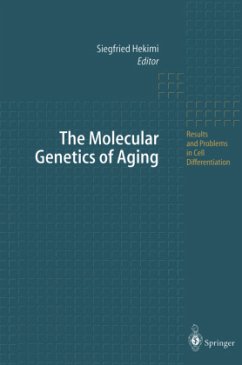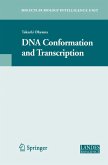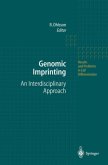The Molecular Genetics of Aging
Herausgegeben:Hekimi, Siegfried
The Molecular Genetics of Aging
Herausgegeben:Hekimi, Siegfried
- Broschiertes Buch
- Merkliste
- Auf die Merkliste
- Bewerten Bewerten
- Teilen
- Produkt teilen
- Produkterinnerung
- Produkterinnerung
The molecular genetics of aging or life-span determination is an expanding field. One reason is because many people would consider it desirable if hu man life span could be extended. Indeed, it is difficult not to be fascinated by tales of the life and death of people who have succeeded in living a very long life. Because of this, we have placed at the head of this book the chapter by Perls et al. on Centenerians and the Genetics of Longevity. Perls and his coauthors convincingly argue that, while the average life expectancy might be mostly determined by environmental factors because the…mehr
Andere Kunden interessierten sich auch für
![Aging and Human Longevity Aging and Human Longevity]() M.-F. Schulz-AellenAging and Human Longevity39,99 €
M.-F. Schulz-AellenAging and Human Longevity39,99 €![Molecular Mechanisms of Membrane Fusion Molecular Mechanisms of Membrane Fusion]() Shinpei OhkiMolecular Mechanisms of Membrane Fusion111,99 €
Shinpei OhkiMolecular Mechanisms of Membrane Fusion111,99 €![The Histone Code and Beyond The Histone Code and Beyond]() The Histone Code and Beyond74,99 €
The Histone Code and Beyond74,99 €![DNA Conformation and Transcription DNA Conformation and Transcription]() DNA Conformation and Transcription110,99 €
DNA Conformation and Transcription110,99 €![The Auditory Brain and Age-Related Hearing Impairment The Auditory Brain and Age-Related Hearing Impairment]() Jos J. EggermontThe Auditory Brain and Age-Related Hearing Impairment97,99 €
Jos J. EggermontThe Auditory Brain and Age-Related Hearing Impairment97,99 €![FISH Technology FISH Technology]() FISH Technology74,99 €
FISH Technology74,99 €![Genomic Imprinting Genomic Imprinting]() Genomic Imprinting37,99 €
Genomic Imprinting37,99 €-
-
-
The molecular genetics of aging or life-span determination is an expanding field. One reason is because many people would consider it desirable if hu man life span could be extended. Indeed, it is difficult not to be fascinated by tales of the life and death of people who have succeeded in living a very long life. Because of this, we have placed at the head of this book the chapter by Perls et al. on Centenerians and the Genetics of Longevity. Perls and his coauthors convincingly argue that, while the average life expectancy might be mostly determined by environmental factors because the average person has an average genotype, extremely long life spans are genetically determined. Of course, studying humans to uncover the genetics of aging is not ideal, not so much because one cannot easily perform experiments as because they live such a long time. This is why most of this book describes the current state of research with model organisms such as yeast, worms, flies, and mice. J aswinski focuses on yeast and how metabolic activity and stress resistance affect the longevity of Saccharomyces cerevisiae. In the process, he discusses the concept of aging as applied to a unicellular organism such as yeast and the importance of metabolism and stress resistance for aging in all organisms.
Produktdetails
- Produktdetails
- Results and Problems in Cell Differentiation 29
- Verlag: Springer / Springer Berlin Heidelberg / Springer, Berlin
- Artikelnr. des Verlages: 978-3-642-53686-1
- Softcover reprint of the original 1st ed. 2000
- Seitenzahl: 260
- Erscheinungstermin: 28. Juli 2012
- Englisch
- Abmessung: 235mm x 155mm x 15mm
- Gewicht: 403g
- ISBN-13: 9783642536861
- ISBN-10: 3642536867
- Artikelnr.: 39173705
- Results and Problems in Cell Differentiation 29
- Verlag: Springer / Springer Berlin Heidelberg / Springer, Berlin
- Artikelnr. des Verlages: 978-3-642-53686-1
- Softcover reprint of the original 1st ed. 2000
- Seitenzahl: 260
- Erscheinungstermin: 28. Juli 2012
- Englisch
- Abmessung: 235mm x 155mm x 15mm
- Gewicht: 403g
- ISBN-13: 9783642536861
- ISBN-10: 3642536867
- Artikelnr.: 39173705
Centenarians and the Genetics of Longevity.- 1 Introduction.- 2 Are Centenarians a New Phenomenon?.- 3 Centenarians Are the Fastest Growing Age Group.- 4 Are Centenarians Different?.- 5 The Centenarian Phenotype: Compressing Morbidity Towards the End of Life.- 6 Evidence from Centenarians Supporting a Strong Genetic Influence upon Longevity.- 7 Siblings of Centenarians Live Longer.- 8 Parents of Centenarians also Achieve Unusually Old Age.- 9 Four Families with Clustering for Extreme Longevity.- 10 Middle-Aged Mothers Live Longer: An Evolutionary Link Between Reproductive Success and Longevity-Enabling Genes.- 11 In Our Near Future.- References.- Coordination of Metabolic Activity and Stress Resistance in Yeast Longevity.- 1 Introduction.- 2 Phenomenology of Yeast Aging.- 3 Genetics of Longevity.- 4 Physiological and Molecular Mechanisms of Aging.- 5 Primacy of Metabolic Control.- Current Issues Concerning the Role of Oxidative Stress in Aging: A Perspective.- 1 Introduction.- 2 The Concept of Life Span: A Cautionary Note.- 3 Metabolic Rate, Stress Resistance and Antioxidative Defenses.- 4 Current Evidential Status of the Oxidative Stress Hypothesis of Aging.- 5 Longevity Studies in Transgenic Drosophila.- 6 Hazards of Life-Span Analysis in Drosophila.- 7 Conclusions.- References.- Regulation of Gene Expression During Aging.- 1 Importance of Examining Gene Expression During Aging.- 2 Drosophila as a Model System for Studying Gene Expression During Aging.- 3 Enhancer Trap and Reporter Gene Techniques Can Be Used to Study Gene Expression During Aging.- 4 The Level of Expression of Many Genes Is Dynamically Changing During Adult Life in Drosophila melanogaster.- 5 Gene Expression Is Carefully Regulated During Adult Life in Drosophila melanogaster.- 6 Some Genes Are Regulated by Mechanisms That Are Linked to Life Span and May Serve as Biomarkers of Aging.- 7 The Expression of Some Genes Is Not Changed by Environmental or Genetic Manipulations That Alter Life Span.- 8 Use of Temporal Patterns of Gene Expression as Biomarkers of Aging.- 9 The drop-dead Mutation May Be Used to Accelerate Screens for Long-Lived Mutations.- 10 Studies on Gene Expression Suggest That Not All Things Fall Apart During Aging.- 11 Conclusions.- References.- Crossroads of Aging in the Nematode Caenorhabditis elegans.- 1 Introduction.- 2 Dormancy.- 3 The Rate of Living.- 4 Caloric Restriction.- 5 How Many Different Mechanisms?.- 6 A Unifying Hypothesis.- Contributions of Cell Death to Aging in C. elegans.- 1 Introduction.- 2 C. elegans as Model for Analysis of Molecular Mechanisms of Aging.- 3 Cell Death.- 4 Roles of Cell Death in C. elegans Aging, Future Directions..- References.- Stress Response and Aging in Caenorhabditis elegans.- 1 Introduction.- 2 C. elegans Life History - Life in a Stressful Environment.- 3 Longevity (Age) Mutations.- 4 Aging and Stress Response.- 5 Stress and Life-Span Determination.- References.- Oxidative Stress and Aging in Caenorhabditis elegans.- 1 Introduction.- 2 Genetics and Environment Causes of Aging.- 3 Isolation of Mutants.- 4 Fecundity.- 5 Life Span.- 6 Aging Markers.- 7 Superoxide Dismutase (SOD) Activity.- 8 Molecular Cloning of mev-1.- 9 Enzyme Activity of Cytochrome b560.- 10 Mutagenesis.- 11 Apoptosis in mev-1 and rad-8 Mutants.- 12 Mechanism of Cell Damage by the mev-1 Mitochondrial Abnormality.- 13 Other C. elegans Life-Span Mutants Show Abnormal Responses to Oxidative Stress.- 14 Closing Comments.- Mutation Accumulation In Vivo and the Importance of Genome Stability in Aging and Cancer.- 1 Introduction.- 2 In Vivo ModelSystems for Measuring Mutations.- 3 The lacZ-Plasmid Mouse Model for Mutation Detection.- 4 Monitoring Mutation Accumulation in Mice with Defects in Genome Stability Pathways.- 5 Summary and General Discussion.- References.- Delayed Aging in Ames Dwarf Mice. Relationships to Endocrine Function and Body Size.- 1 Introduction.- 2 Ames Dwarf Mice.- 3 Snell Dwarf Mice.- 4 Development and Longevity of Dwarf Mice.- 5 Longevity of Snell Dwarf Mice and the Issues of Husbandry.- 6 Possible Mechanisms of Delayed Aging in Dwarf Mice.- 7 General Conclusions and Future Directions.- Stem Cells and Genetics in the Study of Development, Aging, and Longevity.- 1 Introduction.- 2 Development as a Reversible Restriction of Developmental Potential.- 3 Stem Cell Populations Drive Developmental Systems.- 4 Stem Cell Populations as Critical Targets of Damage During Aging.- 5 Hematopoietic Stem Cells as a Model Population for Studies of Aging.- 6 Telomeres.- 7 A Link Between Stem Cell Replication and Organismal Life Span in the Mouse.- 8 Conclusions and Final Thoughts.- References.
Centenarians and the Genetics of Longevity.- 1 Introduction.- 2 Are Centenarians a New Phenomenon?.- 3 Centenarians Are the Fastest Growing Age Group.- 4 Are Centenarians Different?.- 5 The Centenarian Phenotype: Compressing Morbidity Towards the End of Life.- 6 Evidence from Centenarians Supporting a Strong Genetic Influence upon Longevity.- 7 Siblings of Centenarians Live Longer.- 8 Parents of Centenarians also Achieve Unusually Old Age.- 9 Four Families with Clustering for Extreme Longevity.- 10 Middle-Aged Mothers Live Longer: An Evolutionary Link Between Reproductive Success and Longevity-Enabling Genes.- 11 In Our Near Future.- References.- Coordination of Metabolic Activity and Stress Resistance in Yeast Longevity.- 1 Introduction.- 2 Phenomenology of Yeast Aging.- 3 Genetics of Longevity.- 4 Physiological and Molecular Mechanisms of Aging.- 5 Primacy of Metabolic Control.- Current Issues Concerning the Role of Oxidative Stress in Aging: A Perspective.- 1 Introduction.- 2 The Concept of Life Span: A Cautionary Note.- 3 Metabolic Rate, Stress Resistance and Antioxidative Defenses.- 4 Current Evidential Status of the Oxidative Stress Hypothesis of Aging.- 5 Longevity Studies in Transgenic Drosophila.- 6 Hazards of Life-Span Analysis in Drosophila.- 7 Conclusions.- References.- Regulation of Gene Expression During Aging.- 1 Importance of Examining Gene Expression During Aging.- 2 Drosophila as a Model System for Studying Gene Expression During Aging.- 3 Enhancer Trap and Reporter Gene Techniques Can Be Used to Study Gene Expression During Aging.- 4 The Level of Expression of Many Genes Is Dynamically Changing During Adult Life in Drosophila melanogaster.- 5 Gene Expression Is Carefully Regulated During Adult Life in Drosophila melanogaster.- 6 Some Genes Are Regulated by Mechanisms That Are Linked to Life Span and May Serve as Biomarkers of Aging.- 7 The Expression of Some Genes Is Not Changed by Environmental or Genetic Manipulations That Alter Life Span.- 8 Use of Temporal Patterns of Gene Expression as Biomarkers of Aging.- 9 The drop-dead Mutation May Be Used to Accelerate Screens for Long-Lived Mutations.- 10 Studies on Gene Expression Suggest That Not All Things Fall Apart During Aging.- 11 Conclusions.- References.- Crossroads of Aging in the Nematode Caenorhabditis elegans.- 1 Introduction.- 2 Dormancy.- 3 The Rate of Living.- 4 Caloric Restriction.- 5 How Many Different Mechanisms?.- 6 A Unifying Hypothesis.- Contributions of Cell Death to Aging in C. elegans.- 1 Introduction.- 2 C. elegans as Model for Analysis of Molecular Mechanisms of Aging.- 3 Cell Death.- 4 Roles of Cell Death in C. elegans Aging, Future Directions..- References.- Stress Response and Aging in Caenorhabditis elegans.- 1 Introduction.- 2 C. elegans Life History - Life in a Stressful Environment.- 3 Longevity (Age) Mutations.- 4 Aging and Stress Response.- 5 Stress and Life-Span Determination.- References.- Oxidative Stress and Aging in Caenorhabditis elegans.- 1 Introduction.- 2 Genetics and Environment Causes of Aging.- 3 Isolation of Mutants.- 4 Fecundity.- 5 Life Span.- 6 Aging Markers.- 7 Superoxide Dismutase (SOD) Activity.- 8 Molecular Cloning of mev-1.- 9 Enzyme Activity of Cytochrome b560.- 10 Mutagenesis.- 11 Apoptosis in mev-1 and rad-8 Mutants.- 12 Mechanism of Cell Damage by the mev-1 Mitochondrial Abnormality.- 13 Other C. elegans Life-Span Mutants Show Abnormal Responses to Oxidative Stress.- 14 Closing Comments.- Mutation Accumulation In Vivo and the Importance of Genome Stability in Aging and Cancer.- 1 Introduction.- 2 In Vivo ModelSystems for Measuring Mutations.- 3 The lacZ-Plasmid Mouse Model for Mutation Detection.- 4 Monitoring Mutation Accumulation in Mice with Defects in Genome Stability Pathways.- 5 Summary and General Discussion.- References.- Delayed Aging in Ames Dwarf Mice. Relationships to Endocrine Function and Body Size.- 1 Introduction.- 2 Ames Dwarf Mice.- 3 Snell Dwarf Mice.- 4 Development and Longevity of Dwarf Mice.- 5 Longevity of Snell Dwarf Mice and the Issues of Husbandry.- 6 Possible Mechanisms of Delayed Aging in Dwarf Mice.- 7 General Conclusions and Future Directions.- Stem Cells and Genetics in the Study of Development, Aging, and Longevity.- 1 Introduction.- 2 Development as a Reversible Restriction of Developmental Potential.- 3 Stem Cell Populations Drive Developmental Systems.- 4 Stem Cell Populations as Critical Targets of Damage During Aging.- 5 Hematopoietic Stem Cells as a Model Population for Studies of Aging.- 6 Telomeres.- 7 A Link Between Stem Cell Replication and Organismal Life Span in the Mouse.- 8 Conclusions and Final Thoughts.- References.








